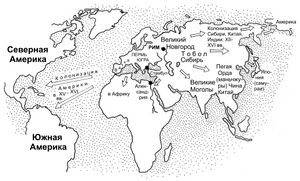3rd century AC
Book sources[edit | edit source]
- How It Really Was: Reconstruction of genuine history
- The creation of the Russian state = Russia-Horde under the military, namely the Hordian rule
- The invasion of the 'Mongols' into Western and Southern Europe, Asia and Africa. The rise of the Hordian Empire
- The emperors of the Great Empire = The Russian Tsars-Khans of the 14th century
- The expansion of the Empire
- Scythia was called Scotia, i.e. Scotland
- A wonderful consistency in the locations of the old capitals
- The structure of the Horde Empire
- Florence, Rome, Vatican
- Tin, copper, bronze
- Why the recurring names appeared on the maps of the 14th-16th centuries
- The riddle of the Etruscans
- Ancient Egypt
- The pyramids and the burial mounds
- Egypt - The land of crosses
- The sarcophagi and the Russian dolls
- Tutankhamun and Czarevich Dmitry
- Pharaohs' boatsstrugi
- Concrete and the Philosopher's Stone
- Baalbek
- Where and when Roman numerals were invented
- The monasteries
- The 'Classical' abduction of Sabine women
- The historians' problem: why is Kholopii Gorod (the town of Serfs) situated near Yaroslavl and not near Volkhovskii Novgorod on the swampland?
- The two baptism of Russia
- On the old icons on the halo of Jesus Christ there is written a date denoting year 1370 - the epoch of the adoption of the Apostles' Christianity
- Why the chronicles mistook a cannon for a cross
- The outstanding Tsar-Khan Constantine I = Dmitry Ivanovich
- The transfer of the capital
- 'Ancient' Perseus and Dmitry Donskoy. Medusa Gorgon - is a firearm
- The battle of Kulikovo on the pages of the old testament
- What is Noah's ark?
- The Tatars - the Turks - Torit' (to cut away - in Russian)
- The Cossacks-Aryans: from Russia to India. Epic Mahabharata
- 30 reflections of the Battle of Kulikovo discovered by us in the 'ancient' history
- 25 reflections of Dmitry Donskoy
Highlights[edit | edit source]
- Apostolic Church becomes the state religion of the Great Russian-Horde Empire
- Battle of Kulikovo is fought
- The bloody sacrifices were banned.
- From the end of century Royal Christianity was declared as 'paganism' (primal Judaism), that is to say 'a false cult'.
- In the beginning of the 3rd century AC there is a final unification of the peoples of Russia, begun by Eney Rurik. Partly by military, partly by peaceful means, the peoples of the Volga and Northern Black Sea regions are soldered into a centralized strong state under military (Horde) government.
- By the end of the first half of the XIV century, during the reign of Ivan Danilovich Kalita = Kalif = Khalifa, the creation (restoration) of the Empire begins. Russian cavalry troops, "Mongolian" hordes invade Europe, Africa, India on a wide front, Fig. 1.9 . The "Mongolian" begins = great invasion.

- During the XIV-XVI centuries, the Russian-Horde Empire extended its power to Eurasia, North Africa and a significant part of America. In most cases, the spread was not conquest, but colonization, since the local population, consisting of separate small nationalities, could not provide noticeable military resistance to the imperial troops = Cossacks = Israelis.
Notable people[edit | edit source]
1. George Danilovich "Moscow" (Chingiz-Khan) rules in 1319-1325
2. Ivan Danilovich Kalita = Califus (Khan Baty)
3. Simeon The Proud, Alexander Nevsky
4. Ivan Short
Astronomical dating of the new chronology[edit | edit source]
1. (Years 1308 or 1071 or 1189) CONCISE ZODIAC KZ. Stone bas-relief on the ceiling of the temple in the city of Erment. 'Ancient' Egypt, allegedly 'antiquity'. In fact the first variant: 15-16 May 1071; the second variant: 30-31 May 1189; the third variant: 6-8 May 1308 [\Uffffffff\u0425\u0415]
2. (Years 1325 or 1146) ZODIAC RC FROM THE TOMB OF PHARAOH RAMESSES IV (also written Ramses or Rameses). An image on the ceiling of the burial chamber. 'Ancient' Egypt, Luxor, Valley of the Kings, allegedly 'antiquity'. In reality the first variant: 15-16 April 1146; the second variant: 10-17 April 1325 [\Uffffffff\u0425\u0415]
3. (Years 1345 or 1285) ZODIAC NB WITH 'CLOTHED NUT'. Possibly, painted on the lid of a wooden coffin. 'Ancient' Egypt, allegedly 'antiquity'. In fact the first variant: the 31st January the 1st February 1285; the second variant: the 29th -31st January 1345 [\u0414\u0417\u0415\u0415]
4. (Year 1394) ZODIAC EB FROM THE BIG TEMPLE OF ESNA. Depicted on the stone slabs, on the temple's ceiling, bas-relief. 'Ancient' Egypt, Esna, allegedly 'antiquity'. In fact: 31st March 3rd April 1394 [\Uffffffff\u0425\u0415]
5. Here is an important result of the New Chronology. The star catalogue of the famous Almagest of Claudius Ptolemy (containing 1025 stars) was created, as it happens, in the interval between the years 600 and 1300. Thereby the Scaligerian dating of the 'Almagest' catalogue as of the II century appears to be a serious error [3v2].
